Small boat tender perfection? Dinghying with ePropulsion, Scanstrut, and West Marine
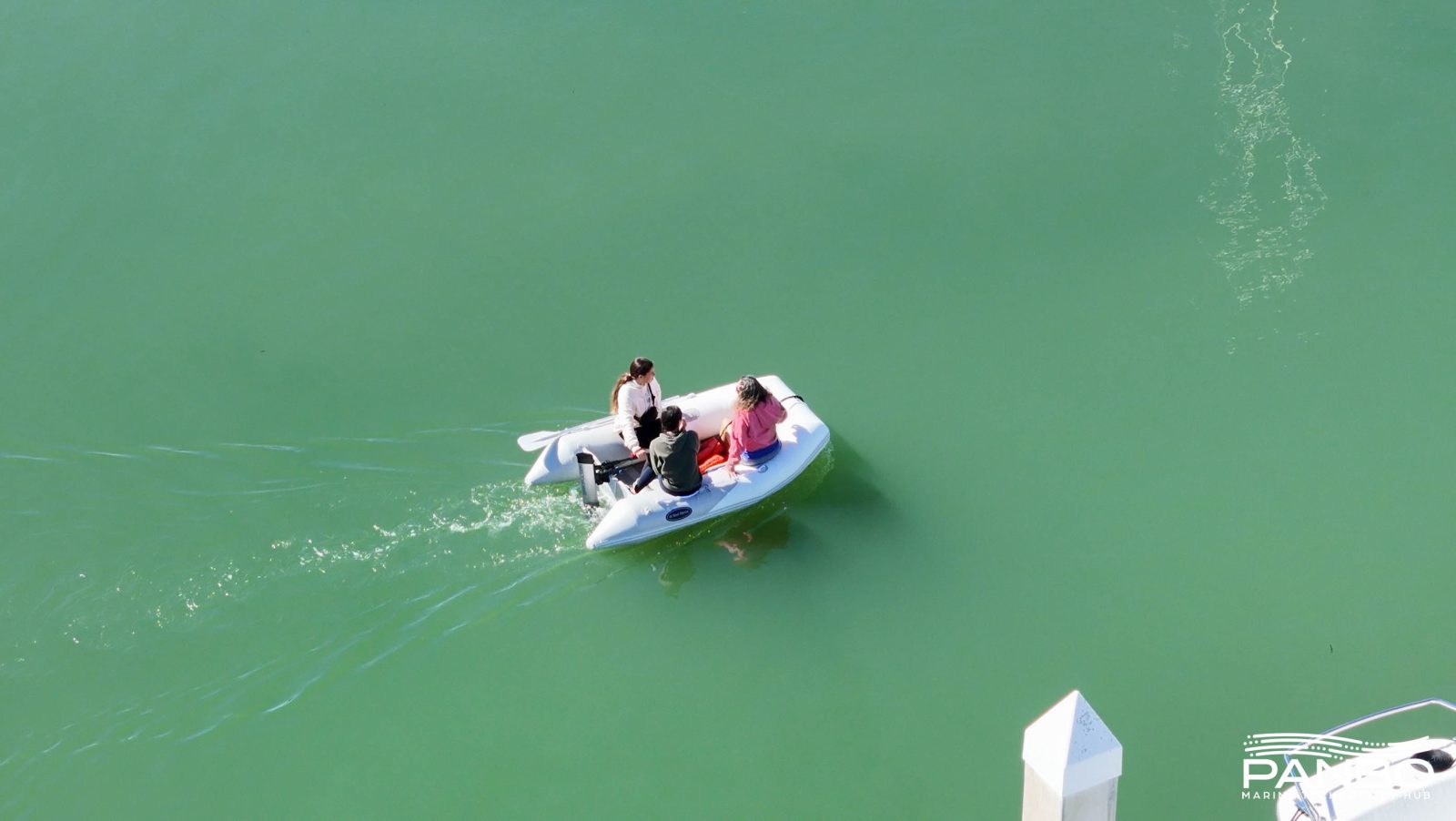
It has been two and a half years since my family and I travelled by water. Since losing Have Another Day to Hurricane Ian, we have lacked a boat for that sort of cruising. But, to be honest, well before losing Have Another Day, we lacked the time to get her off the dock and go explore new places. But, since buying the new Panboat, a 28-foot Edgewater 280cx dual console, we have been determined to spend more time on the water. We’ve been eyeing some short range cruising destinations with nearby hotel options. But, our potential plans included leaving the boat on a mooring ball or at anchor. To do that we would need a dinghy. How do you fit a dinghy on a 28-foot boat? I’m here to tell you how we did it and brag about how well it worked for us.
A Thanksgiving holiday weekend seemed like the perfect time to load up the new boat and get out on the water. We knew we would need hotel rooms since four people on a 28-foot dual console wouldn’t be comfortable — to say the least. We decided on Sarasota because we enjoy the area and know there’s plenty to do within walking distance of the waterfront. Unfortunately, Sarasota’s waterfront also took significant damage in hurricanes Helene and Milton — a sadly familiar story — making transient dockage options limited. Further, the mooring field is currently closed pending inspection of the moorings. No problem! We are experienced cruisers, we can anchor. So that’s just what we did.
Making the trip happen
In order to anchor, we would need a way to get ourselves and our bags from the boat to shore. Although we hatched this plan pretty last minute, quite a few things came together and made this trip possible. First, I just installed Scanstrut’s Atmos inflator system. Second, ePropulsion was able to get me an eLite electric motor quickly. Lastly, my local West Marine had a few PRU-3 inflatable boats in stock.
The boat
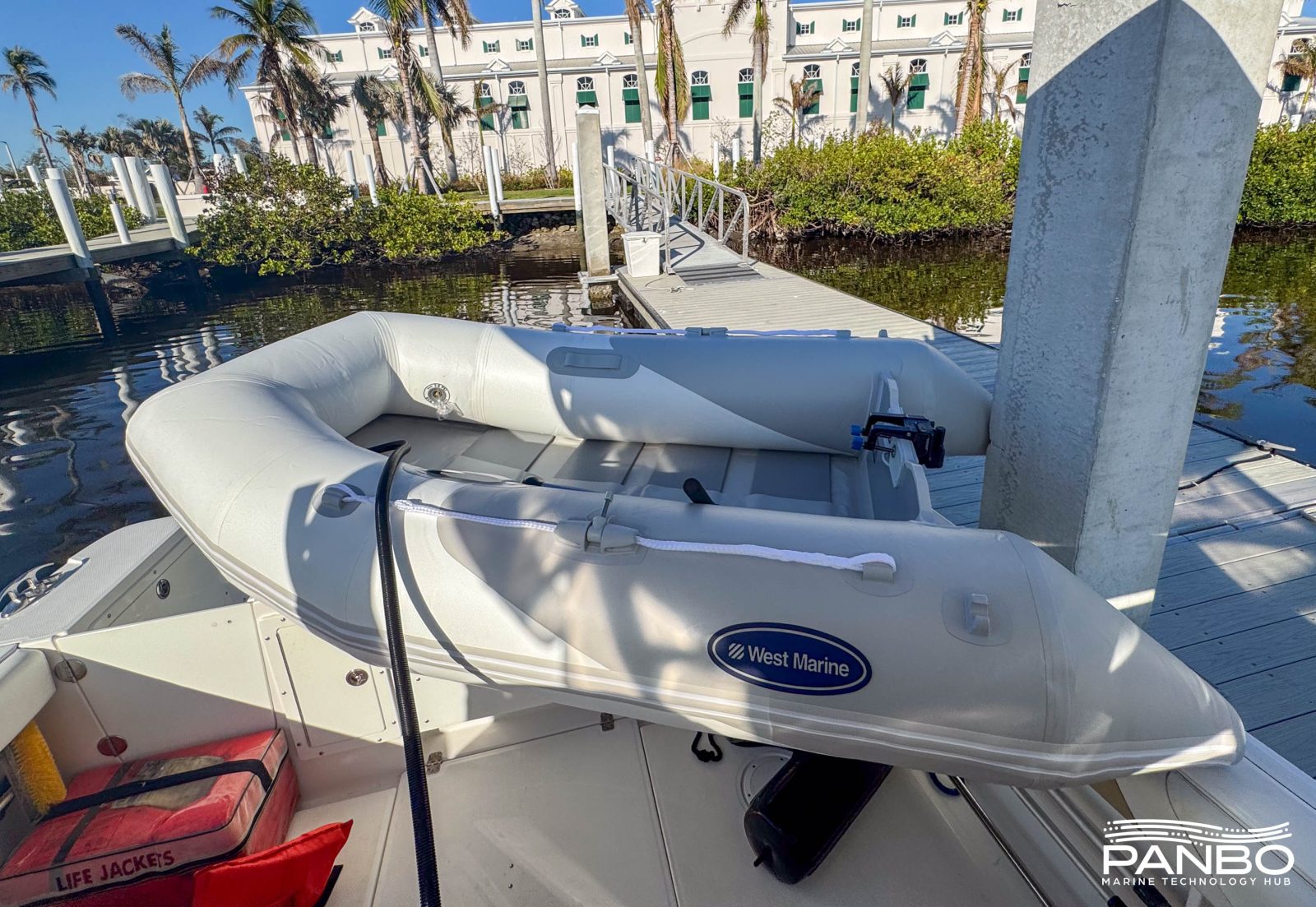
Out of the gate, I knew Panboat’s style and configuration limited our dinghy options. With an open aft cockpit and outboard motors, any sort of davit or hoist simply wouldn’t be practical. So, quickly I focused on pure inflatable boats that, when deflated would fit in the large fish box in the cockpit sole. West Marine’s PRU-3 is an 8-foot, 6-inch PVC inflatable with wooden slats to reinforce the floor. The boat carries three people and up to 992 pounds. At 53 pounds, it’s not a back breaker folded up and wedged into the included carrying bag.
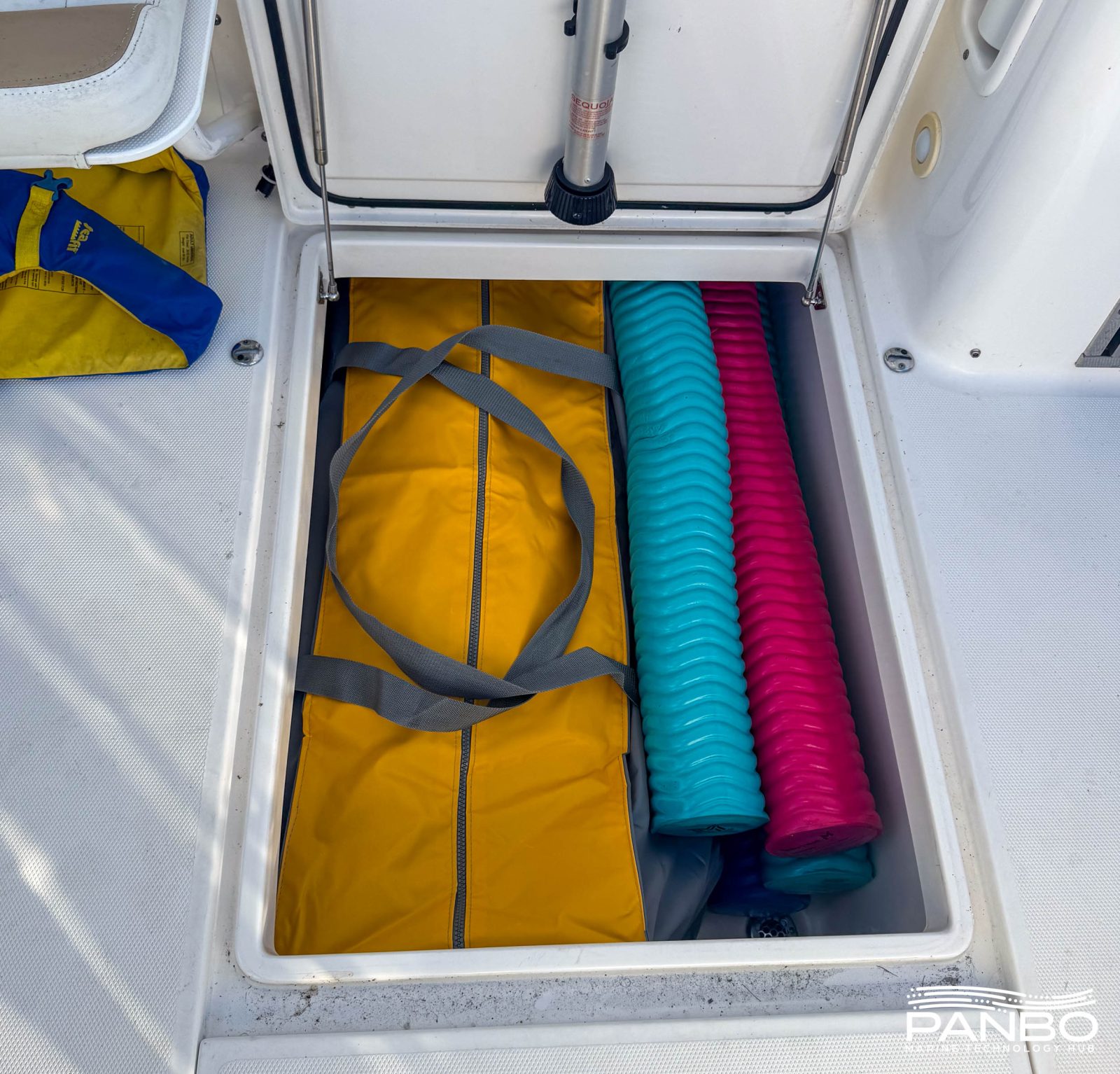
Critically for my purposes, the boat fits nicely in the fishbox and leaves room for a few floats, life jackets, and the electric motor. The boat’s PVC construction won’t hold up to sun and saltwater as well as hypalon. But, I bought the boat on sale for $719. The cheapest Hypalon boat I could find is more than triple that. Additionally, PVC is 10-15 pounds lighter and when you’re hefting the boat around, every pound matters.
The inflator
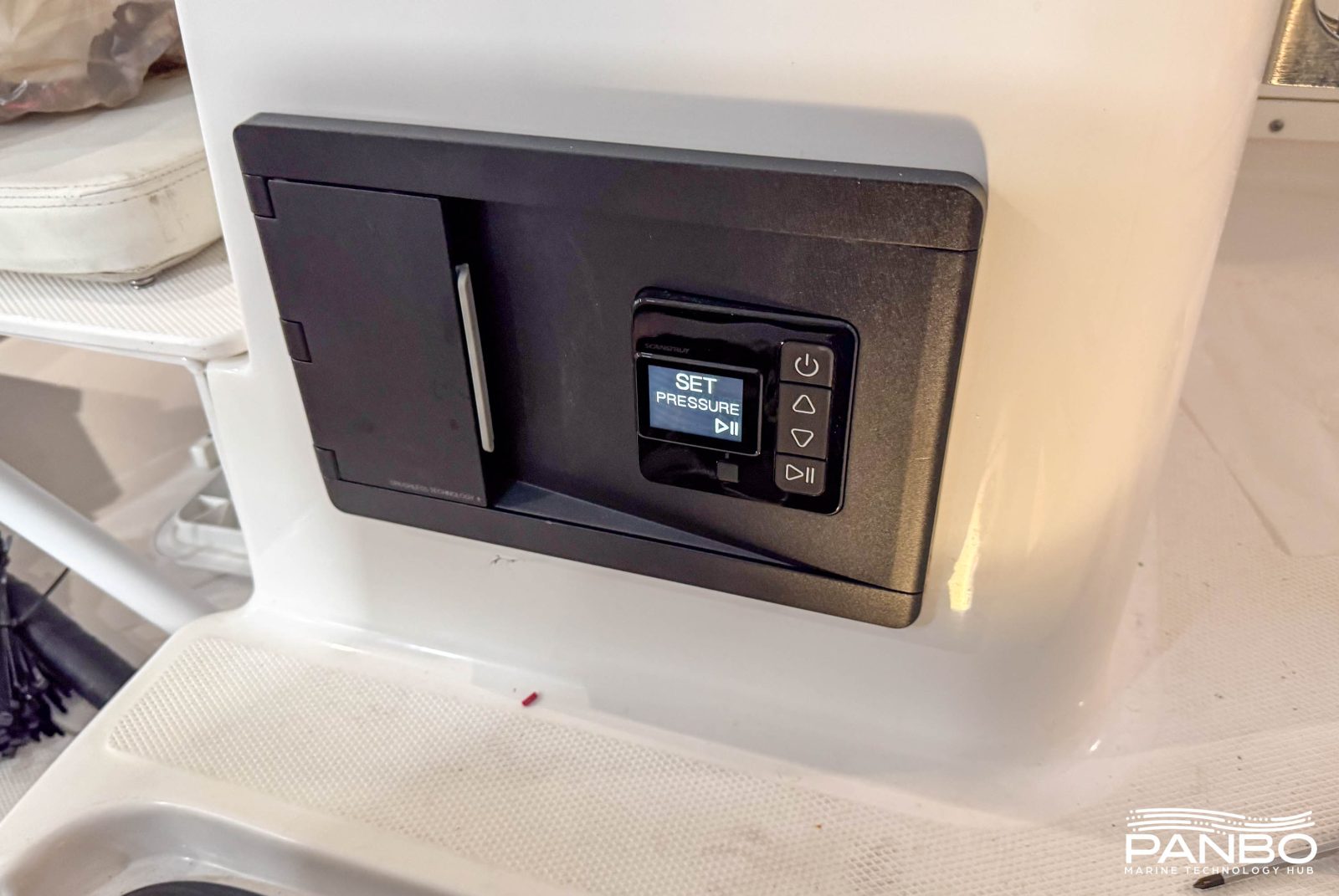
Scanstrut’s Atmos is the first of two products in this review to receive NMMA Innovation Awards from juries in which I participated. Atmos’ win came at IBEX 2023. The thought that went into designing Atmos is clear from a quick look. Scanstrut clearly took the time to understand the use case and design a product to meet those needs. Atmos has a two stage inflator with a low pressure, high-volume stage handling the high volume early inflation before handing off to a high pressure stage that can reach 20 PSI. The roughly $325 Atmos consumes up to 12 amps of 12 volt power. Additionally, ignition protection provides mounting flexibility including in spaces that may contain fuel vapors.
The motor
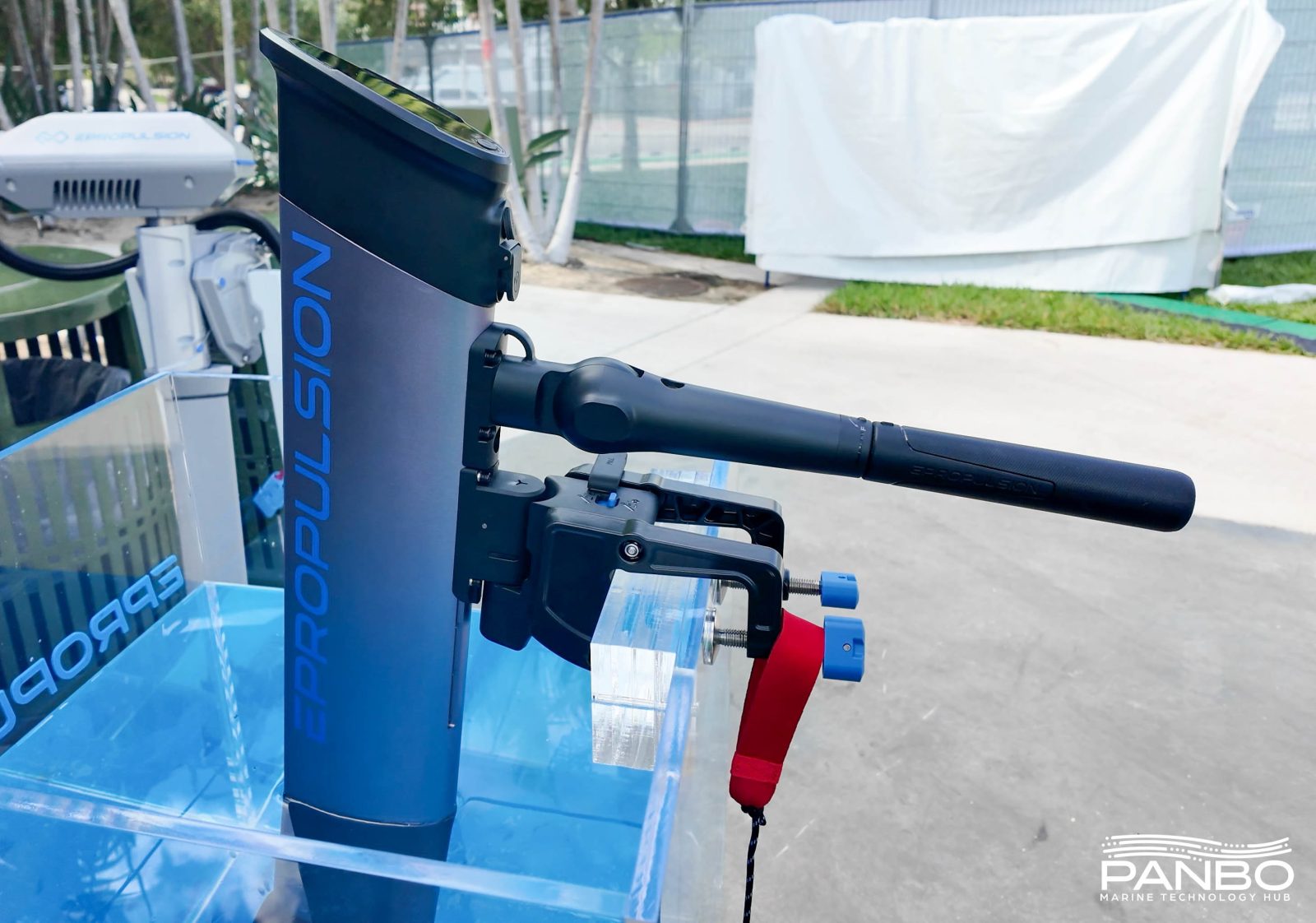
ePropulsion’s $1,000 eLite first caught my eye at last year’s Miami Boat Show where, as part of the NMMA Innovation Awards, we gave it an award. I clearly remembered that all of us were impressed by the simplicity, value, and large potential market for this little motor. The eLite is a 500 watt electric outboard with internal batteries.
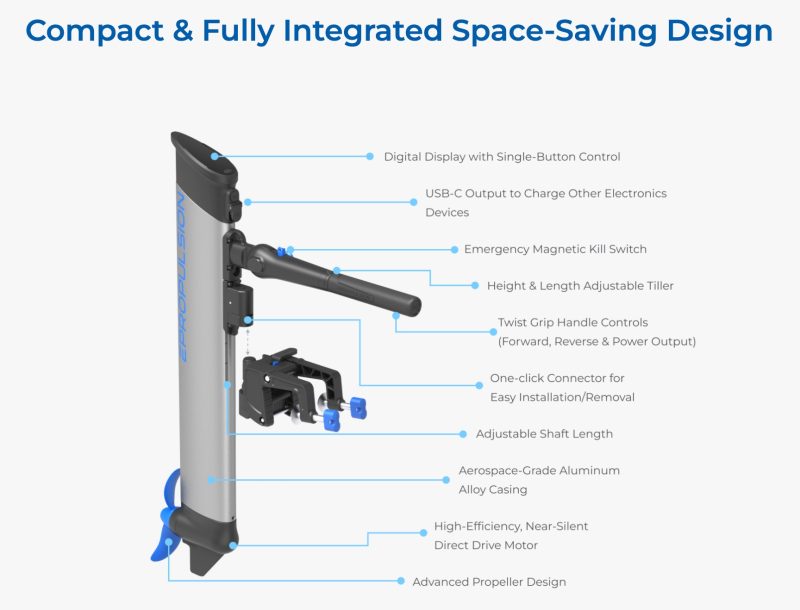
The motor weighs less than 15 pounds and with the transom mount totals just under 17.5 pounds. With the handle rotated down along the motor, it is well balanced and easy to carry. It clicks on to the transom mount easily and releases with the press of a button. The motor doesn’t float, so care is needed when attaching and removing it. The tiller handle extends out about 10 inches to make an easier reach if you sit forward in the boat. Forward comes with a counter clockwise twist and reverse clockwise.
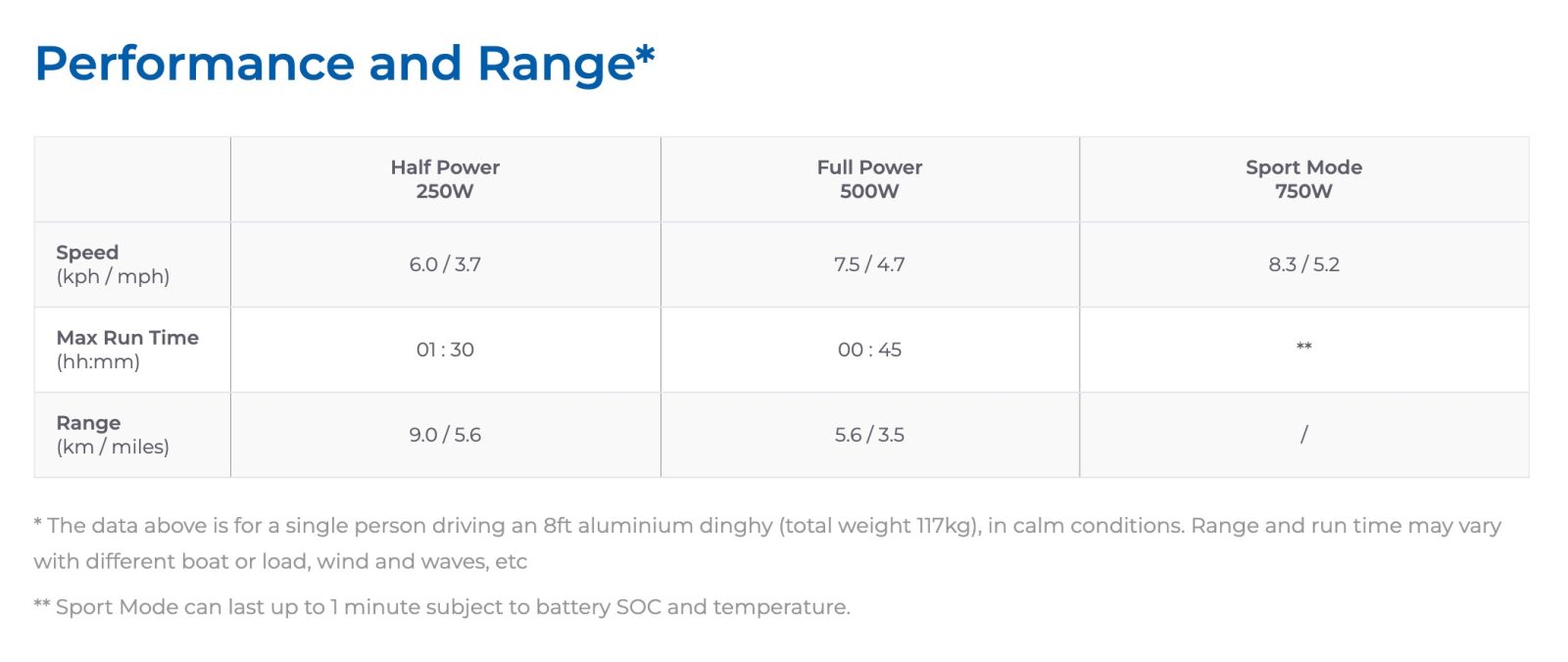
The motor offers a sport mode by double clicking the power button. Sport mode delivers an extra 250 watts for up to one minute. At partial throttle, ePropulsion says the eLite will deliver over 5 miles of range and still over 3 miles at full throttle. If your primary use for a dinghy or tender is to get from a mooring to shore, occasionally run in from an anchorage, or other similar applications, the eLite will work very well for you. On the other hand, if your plan is to spend the day in your dinghy exploring miles of coast, there are better options.
In case you are wondering, 500 watts equates to two thirds of a horsepower. The 750 watt, one minute long sport mode is equal to one horsepower. But, at displacement speeds it is quite remarkable how little power can be needed to propel a boat along smartly.
Putting it all together
As I mentioned, the whole point of this exercise was to have a useable dinghy to use when travelling aboard Panboat. I’m pleased to report that we are back from a holiday weekend in Sarasota where the inflator, dinghy, and motor all worked to perfection. We arrived at our anchorage, dropped the hook, inflated the boat, and mounted the motor all within about 15 minutes. Once the motor was on the boat, it easily made the trip back and forth from our anchorage to shore. With four of us and a load of bags, we made two trips. Each round trip was just over half a mile. After two round trips, the eLite’s battery meter showed 85 percent charged.
I’ve blown up more than my fair share of stand up paddle boards, water sports towables, and inflatable boats. Seemingly no matter the temperature, just a few minutes in, I’m dripping in sweat and questioning nearly all of my life’s choices. Atmos makes the task a pleasure. Just dial in the pressure, press start, and wait for the unit to finish. Equally important to the ease of inflating the boat, Atmos offers a deflate function. We intend to store the tender in its case in the floor of the boat. If you’ve ever repacked an inflatable boat, you have some idea of the effort typically required to get one back in its case. Atmos deflates with as little effort as it inflates and made getting the boat back in the bag quite easy.
I tested speed at about one third, half, full, and sport mode and found all four nearly exactly matched the speeds ePropulsion quotes. Mostly, I found that power above about 350 watts primarily resulted in slightly increased noise, a bit more turbulence in the water and little increase in speed. My setup effortlessly cruised at 4 miles per hour and anything more felt like wasted energy. Given the flat, inflatable floor of the boat, I think the performance is just fine.
Although I’m very happy with the setup, I do have a few small gripes. First, I found the magnetic key used both to activate the motor and as a safety lanyard was too easy to pull out of its docking position on the motor. The result is that I frequently shut off the motor by just moving around a little. While I’m airing my grievances with the motor, I did run it entirely down, but not to zero percent state of charge. That’s because when it got down to four percent, it beeped once and shut off. It wouldn’t turn back on until I charged it. I realize most people probably won’t get close to the bottom of the charge in the battery. However, especially on a motor with a non-removable battery, I’d prefer to at least see zero percent or even a buffer below.
Despite those small complaints, eLite is just about perfection for my needs. The motor is light, easy to get on and off the transom mount, and easy to carry once removed. Plus, once removed from the boat it is unobtrusive. I believe last weekend is the first time in my life I’ve walked into a hotel lobby and checked in while carrying an outboard motor. I don’t think that would have been as popular if I’d been toting a gasoline engine around.
As long as I’m nit picking, Atmos includes an 8-foot long inflation hose. At first glance, that probably sounds like plenty of length. Blowing up the boat, I found otherwise. I’ve mounted the inflator a bit forward of the cockpit area between the helm seats. With the dinghy transverse across the cockpit, it was a tight stretch to get the hose to the aft tube. On my boat, a 10-foot hose would be welcome for the little bit of extra reach it affords.
Final thoughts
This entire setup lists for just over $2,000, which strikes me as an awfully reasonable expense for a fully usable cruising tender. Especially since there is basically no fuel expense. Additional benefits include not having to pull start a small — often cantankerous — motor, nor ever having to clean the gunk out of tiny carburetor jets. It has been thirteen years since Ben Ellison extolled his love for Torqeedo’s Travel electric outboards. So much of what he said in that piece is true of the eLite. Plus, the eLite is half the weight of the Travel and significantly cheaper.
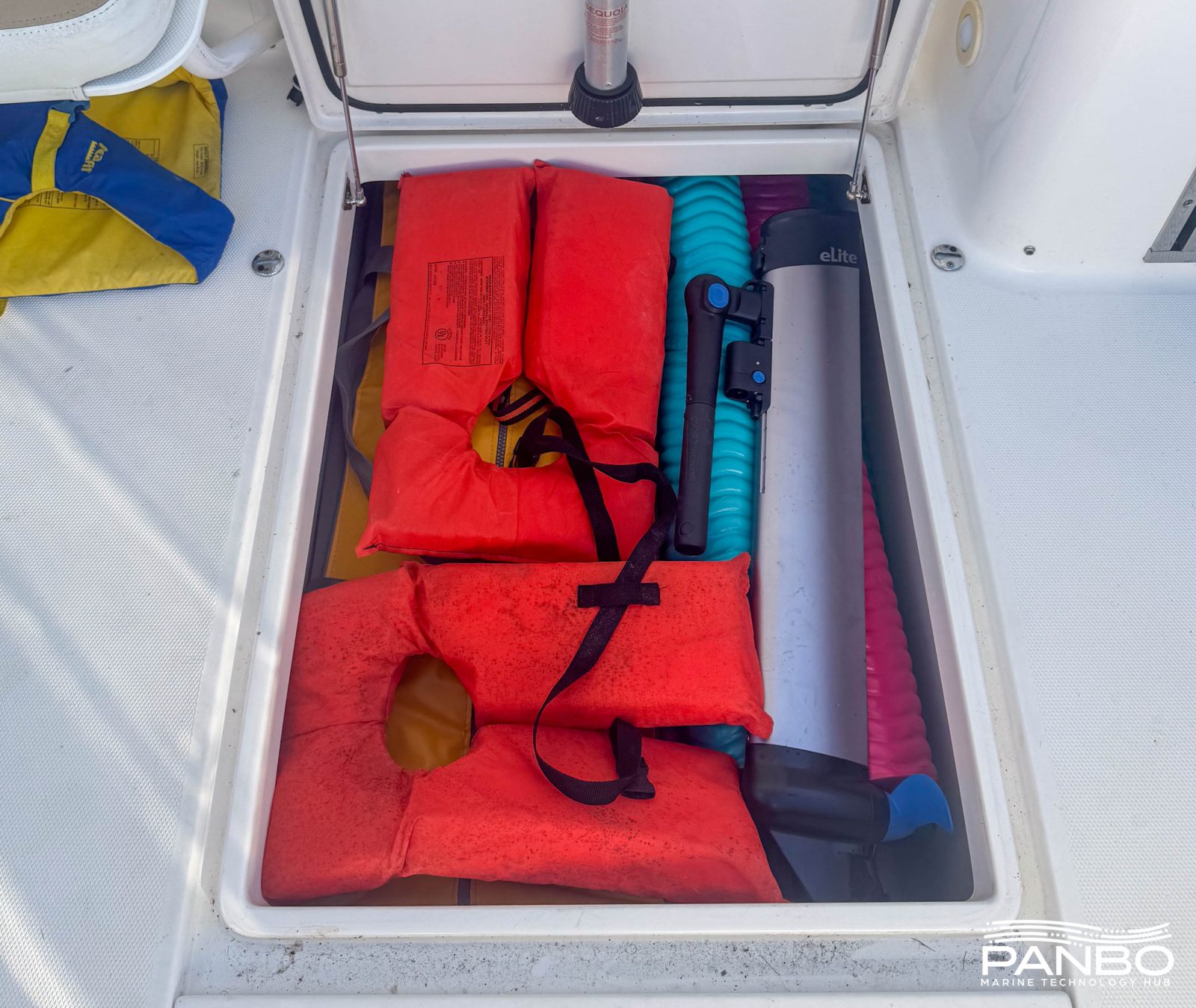
This setup isn’t for every boat or boater. But, on a small boat where space is at a premium, this option made for an efficient and enjoyable means of getting to shore. I am not sure what the future holds for electric propulsion in larger boats, but I firmly believe that in this size of boats, an electric outboard is superior in nearly every respect.


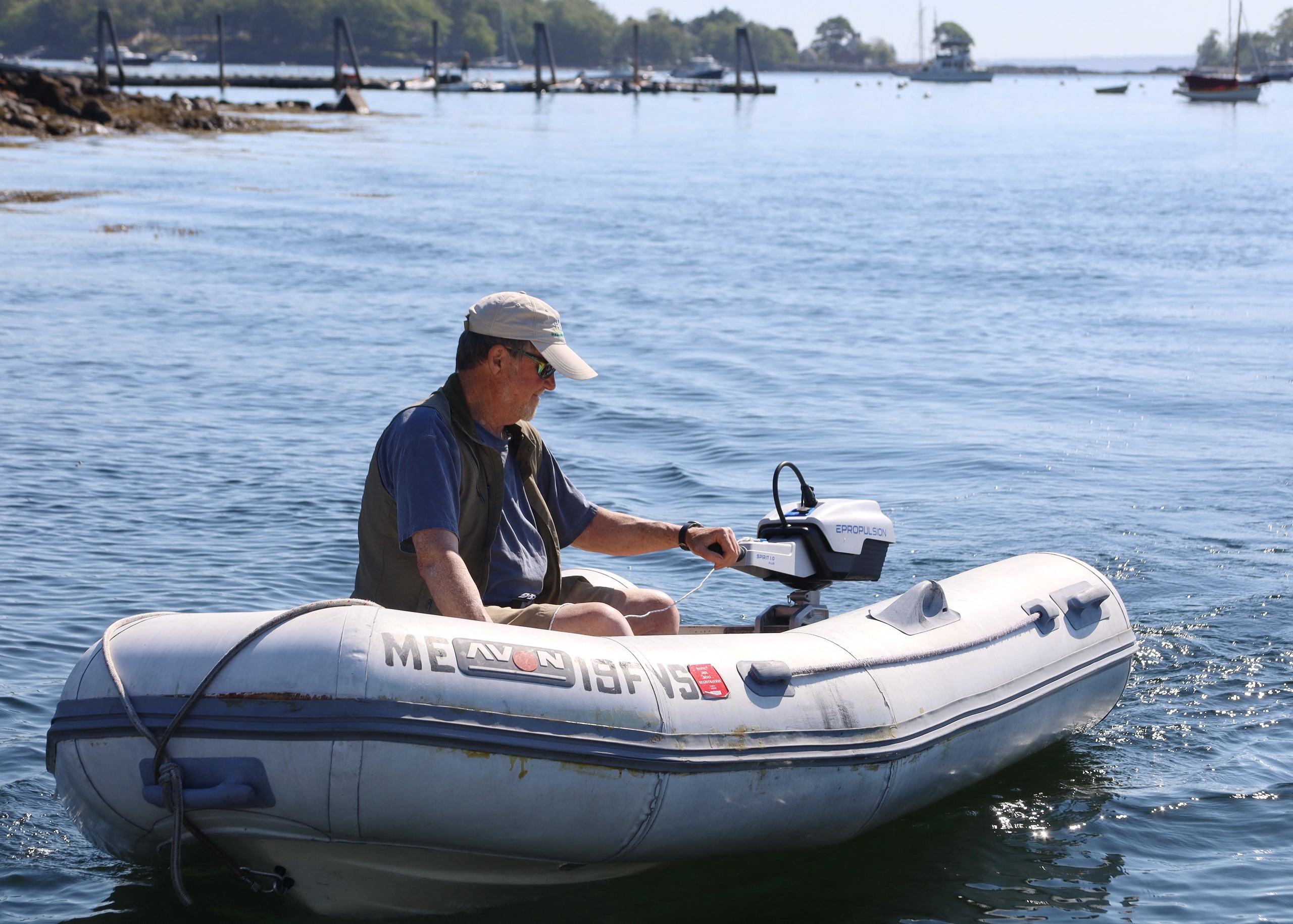


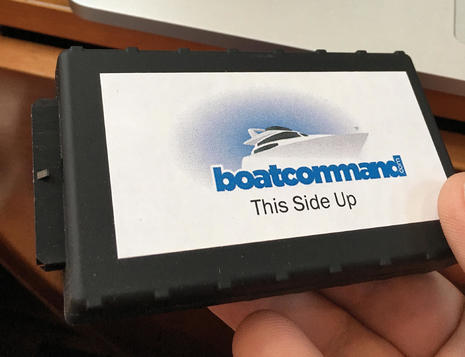







Great summary – sounds like a great option.
Very well thought out and executed. This should be a big deal in the coming years as more and more cruisers transition away from gasoline.
The setup would be particularly useful on diesel cruisers by eliminating the need to have gasoline aboard. The inflatable could easily be boarding platform mounted while inflated needing only infrequent topping up with air.
Ben,
Great summary with plenty of detail for potential purchaser.
My wife and I are doing the Loop piecemeal. Our latest section was South from Jacksonville, FL down to Okeechobee, across and North to St. Petersburg. We alternated between anchoring out and staying in marinas. We inflated our Avon dinghy at a public landing in Jacksonville and pulled it the entire way. I’ve spliced a decent tow bridle. We’re powering the dinghy with a 3hp Yamaha two stroke. Inflating the dinghy and deflating at endpoint is a bit of a chore. We put our pickup and trailer in storage in Jacksonville and drove a rental back to pick up rig and retrieve in St. Pete.
We’re traveling on a 1977 Albin 25 foot trawler with 35 hp Kubota. As you can tell, we’re trying to lowball costs. Dinghy also doubles as lifeboat which I hope we never need. It also can act as reserve motor if reliable Kubota quit. Under hip tow Albin will travel at 3 knots with Yamaha at 3/4 throttle.
Interesting to see a review of the PRU-3! I’ve used my current PRU-3 for 5 seasons in Alaska, stored inflated on the roof of my 28 ft stitch-n-glue cabin-cruiser (Great Alaskan design) from March through October. It is the lightest tender with its specifications/price I have found. The light weight is critical for hand-hauling it up onto my roof, and because the Great Alaskan is a planing boat so weight is critical. I have to clean the UV gunk off it annually, which takes 3-4 hours using a polisher with a stiff bristle-brush pad and Starbrite Inflatable Boat Cleaner, followed by 303 UV protectant. Even with the annual cleaning, pretty heavy use, dragging across rocky shorelines, and 20-hr UV exposure due to our long days, it is still in excellent condition. I can highly recommend carrying Tear-Aid Type B patch tape – best way to patch PVC in the field. As for the motor, well, I’ve been very happy rowing mine, even fighting 2-3 ft chop getting back to the boat on the more adventurous days. There are also many very compact 12V hand-held pumps with alligator clips to connect to a battery that work great, though they’re loud. I carry a foot pump to top off and when going ashore (with the Tear-Aid) in case of bears, rock punctures, etc. Enjoy!